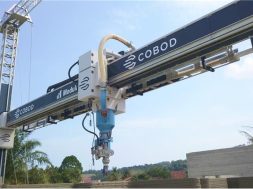The art of high-rise facade
Gone are the days when we saw the buildings with off-white, grey, blue, or just in pale colours. Today if you have a look outside in the metro cities, every building has a clean, shiny and a crystal clear view, where you can see yourself. The magic is nothing but glass made buildings, which also tells, the use of glass is no more restricted to windows and doors. Glass is a major contributor for a modern day architecture, which adds beauty to the building. Glass itself is a wonderful material with few advantages such as: transparency, natural sun light, blending of exteriors and interiors. It is also a recyclable material which provides unrestricted use to the architects and designers for the innovative applications in building. Today’s buildings are going green and are proving as energy saving, in the same line glass plays effective role in saving energy. Energy can be saved by using solar glass control, thermal insulating glazing, low reflective glass, and one can also reduce sound pollution by using sound reducing glass, etc. Glass is one of the best ways to natural sunlight, thereby reducing use of artificial lights.In this article, experts from the industry detail on how far the use of glass is effective, how to select right kind of glass for high-rise buildings.
Importance of glass Glass today, has become an integral part of modern day architecture. It not only gives the designers the choice of finish and a manifestation to their design aspirations, but also a wonderful chance to participate with the outside world. Use of glass is really important in the high-rise buildings today. As the whole world is talking about green building concept and energy saving, glass plays a major role in achieving the same. On this note, Rajiv Balaggan, Sales Head – Architectural Glass India, Pilkington Glass India Pvt. Ltd., says, “We can save a lot on energy by using high performance, energy saving glasses in the building. Apart from energy saving, glass also provide looks and beauty to the building. It not only satisfies the requirement of an architect in terms of aesthetic looks and design. It also helps in saving energy as well. Overall glass is a recycled product.”
Building, enveloped with glass gives an altogether different look, not only from the outside of the building but also from the inside. Mr Somasundaram Senthilkumar, Business Head – Projects, Asahi India Glass Ltd. (AIS),highlights importance of glass and its inherent benefits as a building material, some of which are:• The product is 100 per cent recyclable.• The source of making glass is Silica sand, which is available in abundance, avoiding the risk of resource depletion.• It can offer a structural strength that is comparable with a brick wall coupled with very good sound insulation and fire rating.• The product has the unique property of letting in natural light which is so essential for enhancing the living conditions inside the building. Studies have suggested that more natural daylight in hospitals have actually expedited the recovery time in patients.• Because of the less space it occupies, it gives more manoeuvrable space inside the building and also brings down the dead load weight of the building marginally.• The embodied energy of glass is much lower when compared with Aluminium, cement or paint. This is made possible because of improvement in manufacturing techniques and also of the long life span that glass offers, once it is installed in a building.
On the positive note, glass plays an important role by modernising the tall buildings as it is recyclable material.
Glass for high-rise buildingsGlass is an essential part of design for a tall building in modern day architecture. Apart from its aesthetical value, glass facades in a building exterior should also fulfil basic criteria like protection against fire, forced intrusion, climatic influence etc. Therefore, selection of glass plays a significant role in high-rise building. Some of the range of glasses that are used for high-risers are:
Tempered or toughened glass: Glass is strong to compressive forces and weak against tensile stresses. Toughening is a process which makes the glass invulnerable to tensile stresses too, by imparting strength to the glass that makes it 4 to 5 times stronger than normal annealed glasses. In the event of breakage, tempered glass breaks into small, relatively blunt glass fragments.
Laminated glass: Laminated glass offers protection for people and property by providing an effective barrier when under attack. Also, it has excellent sound insulation properties.
Reflective Glasses: A metallic coating is applied to one side of the glass in order to significantly increase the ability of the glass to reflect both the visible and infra-red (light and heat) range of the electromagnetic spectrum. Reflective glass is also known as solar control glass, which reduces heat gain and glare from the exterior and allows optimum visible light transmission to the interior. It facilitates energy savings through reduction in interior solar heat gain and cost reduction in the cost of heating and cooling systems. It also improves occupants comfort as interior temperature variations are less and easier to control and it reduces the air- conditioning load of the buildings.
Explaining the kind of glass to be used for high-rise, Mr Balaggan, suggests, “In high-rise buildings, the glass need to be either higher in thickness or laminated one, although later one is preferred but all depends on the requirement of the building or glass panel sizes. Glass need to be thicker and tempered one so that it can sustain the wind pressure, which usually a big concern in the high-rise buildings. Thicker or laminated glass are not only required for safety but also helps in the acoustic control. It should be a high performance glass, so that energy saving factor can be achieved without sacrificing on incoming natural light. Using self-cleaning glass as an outer glass helps in maintaining the clear glass facade, taking away the manual cleaning work of facade.”
The kind of glass used decides the impact on the building. There are several reasons because of which a glass failure can occur. High-rise building often faces wind pressure, this is when the time is to check the quality and sustainability of the glass. Glass failure can occur due to wind pressure and thermal stress. While explaining the reasons for glass failure, Mr Senthilkumar states, “Construction of high-rise buildings requires structural systems to withstand high wind loads as near high-rise buildings, the local wind speed is high even in summer. Glass failure can occur because of impact (localised contact with a force which can overcome the strength of the glass) or thermal stress that is when the centre of the glass is heated by the sun and the edges remain cool, the centre of the glass expands but is restricted from natural expansion by the cool edges. This results in stress within the glass that could cause thermal breakage.”
Latest trends in glass In recent times, the idea of green buildings has gained momentum. Builders, developers and architects are increasingly looking to make use of green materials like glass to add a new dimension to their buildings. Many companies are upgrading their technology and manufacturing various kinds of glass to fulfil the desires of modern aesthetic looks as well as with safety concerns. Today the trends are highly focused on eco-friendly and energy saving glass products. Use of clear and transparent and neutral shades are more in order to receive more sunlight. Detailing us on the latest trends in glass that are used for building, Mr Balaggan, says, “Presently, the trend is to go with clear, neutral shade, light shade glass so that natural light receiving is more for the building. Along with natural light and colour, glass must achieve the minimum required performance so that building saves on energy as many buildings are going for energy certifications. Thicker or laminated glass units are in use so that safety concern is addressed along with the sound insulation.” Double-glass units (DGU) (tempered glass) are also in use to achieve on thermal insulation and Sound insulation, up so some extent.
The innovations in glass processing technology to develop products that are under green parameters is increasing rapidly. The companies are competitively manufacturing both single-glazed and double-glazed products allowing architects greater choice and the ability to explore newer possibilities. These solutions enhance the aesthetics and efficiency of commercial and residential spaces, and present builders with viable, attractive and economical alternative to traditional building materials.
Mr Senthilkumar, explains that, today the trend in the glass are not limited only to beauty but also have energy saving properties. He shares, “Energy Efficient Glass ranges from AIS, under the brand name of “Ecosense” provides the benefit reducing the heat gain in buildings due to its excellent energy saving properties without compromising on the natural light coming inside the building or the brilliant aesthetics that add value to the façade. And in winter, they ensure solar gain. Ecosense comes in three ranges – Enhance (Solar Control), Exceed (Solar Control Low-E) and Essence (Low-E) high performance Glasses.”
Smart glazing refers to electrically switchable glass or glazing which changes light and heat transmission properties when voltage is applied. Asahi India, recently launched AIS Swytchglas which is a special glass that turns from being transparent to translucent, and vice versa, with the press of a button. It is made using Polymer Dispersed Liquid Crystal (PDLC) film, and operable with both remote and manual control, it ensures instant privacy in contemporary form. It is ideal for personal spaces, office cabins and modern conference rooms.Are glass safe?Glass is a very fragile material, even a single piece of stone can break it. This is a common fear with use of glass. But in the case of high-rise buildings quality of glass is high, which are safe enough to use. And with the new developments the developers are finding glass as safest mode for building. The whole world is using glass in their buildings without any threat on Safety. The only concerned here is to follow safety norms.
Experts from the industry have given a positive nod to the use of glass. On this note, Mr Balaggan, says, “Glass buildings are safe if people follow the norms and conditions, set by the concerned professionals from the industry. Earlier there was a safety concern in glass buildings in India but with some new changes in the use of glass and glass facade, it is very safe now.”
A commonly perceived notion is that glass compromises safety and security. However, continuous research and technology advances have made glass safer and more secure that it ever was. Solutions like laminated glass in its various types are being widely used for the purpose of accidental protection. Some of the exclusive range of glasses used for safety purpose are : Valuglas (heat-strengthened laminated glass with 1.14mm PVB interlayer), Securityglas (Intrusion-resistant laminated glass with 1.52 mm PVB interlayer), Securityplus (Dupont Sentry Glass interlayer makes it 5 times stronger and 100 times stiffer than conventional laminating materials), Acousticglas (noise-cancelling glass).
Mr Senthilkumar, finds that use of laminated glass can be a better option from the safety point of view. He explains, “Laminated glass is a type of safety glass, that holds together when shattered. In the event of breaking, it is held in place by an interlayer, typically of polyvinyl butyral (PVB), between its two or more layers of glass. The interlayer keeps the layers of glass bonded even when broken, and its high strength prevents the glass from breaking up into large sharp pieces. This produces a characteristic ‘spider web’ cracking pattern when the impact is not enough to completely pierce the glass.”
Due to the superior features, and safety norms glasses are extensively used for doors, windows, facades, canopies, glass flooring, staircases, etc.
ConclusionSelection of right kind of glass plays a crucial role in high-rise building. After a long research and development, glass is considered as safe material for the building. India, is experiencing the beauty of glass on high-rise building. Hopefully, the high-rise building will continue to use glass without any threat. _____________________________________________Glass buildings are safe if people follow the norms and conditions. Rajiv Balaggan, Sales Head – Architectural Glass India, Pilkington Glass India Pvt. Ltd._______________________________________________________________________
Today the trend in the glass are not limited only to beauty but also have energy saving properties.Somasundaram Senthilkumar, Business Head – Projects, Asahi India Glass Ltd.________________________________________________________________________
32
Cookie Consent
We use cookies to personalize your experience. By continuing to visit this website you agree to our Terms & Conditions, Privacy Policy and Cookie Policy.









